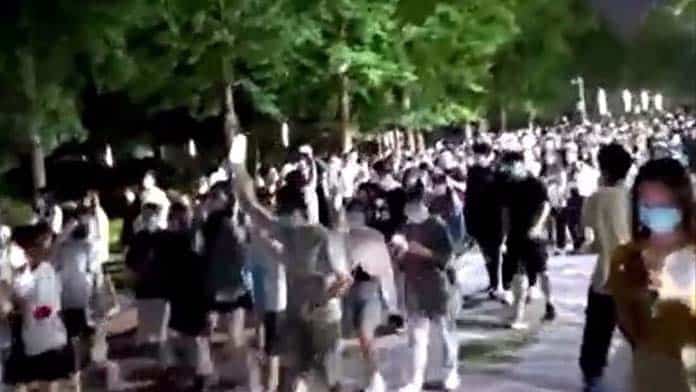After two months of total lockdown, some semblance of normal life has started to return for most of the 28 million people who live in Shanghai, China’s largest and richest city.
However, the Shanghai lockdown was just one—the most important—of many.
Through March and early April, at least 23 major cities, with a combined population of 193 million people, implemented full or multi-district lockdowns. These included Shenzhen, home to 12 million people on the border with Hong Kong and the centre of China’s computer, smartphone and hi-tech industries; Dongguan, the nearby manufacturing powerhouse, home to another ten million people; Changchun, the capital of Jilin province with nine million people; and Shenyang, the capital of northeast Liaoning province and former capital of the Manchu empire.
This wave of lockdowns was driven by rapidly rising COVID infections, which were testament to the unsustainability of the Chinese government’s “dynamic zero COVID” policy.
The world has long known that the Omicron variant is so contagious that a single infection, if unchecked, can spread to literally millions of people in a few months.
The Shanghai government tried to contain COVID by a strategy of targeted lockdowns and selective restrictions on people’s movements. By late March, cases were rising, but the high vaccination rate in Shanghai meant that no-one had died, and there were limited cases of severe illness.
Despite this, the government announced on 28 March that it would lock down the entire city for a week. That day 50 symptomatic and 3450 asymptomatic cases were recorded. Over the following two weeks, despite the near total lockdown, daily new infections rose and peaked at 3590 symptomatic and 25,173 asymptomatic and took six weeks to decline enough for the lockdown to be lifted.
There are still significant restrictions on people’s ability to move around.
Lockdown and repression
The experience of the Shanghai lockdown was horrendous. Millions of people found themselves confined to their apartments. Not only were they unable to go to work or school, they were prohibited from going outside to buy food or other essentials, or to get medical attention.
The Shanghai government seems to have been completely unprepared. People waited weeks for food deliveries, and these were small and the contents of the food packages quite random. Some would get a few eggs, noodles and some green vegetables, others entirely different food.
This official incompetence led millions of people to use social media apps to organise their own food supplies, banding together to order large quantities directly from shops and warehouses.
People who tested positive and their family members were forcibly taken to makeshift hospitals which were often little more than camp beds in large warehouses, with no medical attention.
There were nightmare stories of people dying because the hospitals refused to admit anyone who failed to present a negative COVID test; of children who tested positive being separated from the rest of their family, their whereabouts unknown; and of a 13-year-old who was forced to look after himself for 66 days because his parents had been locked down in Shanghai.
The temptation in the western media has been to use these stories to reinforce a narrative of China’s government as a heartless, totalitarian monster. They ought to reflect on the similarity between the experience of many in Shanghai and the experience of people living in the public housing towers in Melbourne who also found themselves suddenly locked into their apartment buildings with no food or medicine, and no information. It wasn’t just in Shanghai that people were told to ring numbers where no-one answered the phone.
Resistance
This trauma has also sparked moments of resistance and self-organisation. In Shanghai, residents in some areas fought police and neighbourhood party committee-members, while hundreds of thousands came out on their balconies at night banging pots and pans in protest at being locked up without food and other essentials.
The severity of the Shanghai lockdown also sparked a series of student protests in Beijing in mid-May when faced with new COVID restrictions. At the China University of Political Science and Law, hundreds of students rallied, their mobile phone flashlights turned on, demanding the right to go home.
At Peking University, students moved to more direct action when steel fences were set up to keep them locked in their dormitories while academics were allowed to leave campus. In both cases, the university administrations backed down. At a student rally at Beijing Normal University, where in-person classes were cancelled and students required to stay in their rooms to study online, some chanted slogans associated with the peasant uprising of 209BC. The spirit of revolt is never far from the surface in China.
Even where city administrations have avoided total lockdowns, there have been severe restrictions on people’s ability to move about. Measures have included the shutting down of public transport and allowing just one member of a family to shop for food once a week. In Shanghai many factories were allowed to reopen during the lockdown, provided they used a “closed loop” system. This required workers to live and sleep in the factory and not go home until the lockdown ended.
One of the most striking features of China’s series of lockdowns is how often city administrations have made the same mistakes, despite two years of experience on what can go wrong, and two years to prepare.
Complaints about lack of food, of being denied urgent medical care, of family separation, of bureaucratic cruelty were widely publicised during the first lockdown, in Wuhan in early 2020. Yet when the major industrial city of Xi’an was locked down in December 2021, there were also complaints of a lack of food and difficulties accessing health care.
It is reported that the surge in COVID cases that led to the Shanghai lockdown was caused by the virus circulating through the air-conditioning system in a quarantine hotel.
The economic cost of the 2022 lockdowns has been staggering. Shanghai is at the centre of a large proportion of Chinese manufacturing and is its greatest transport and export hub.
Production of manufactured goods has been disrupted across the country as the making of components has been stopped and freight severely disrupted. Around the world, businesses that import from China have faced massive shortages and delays getting orders.
Economic growth in China is predicted to fall to around 4 per cent, one of the lowest rates since the turmoil of the Cultural Revolution in the 1970s, and that figure assumes the lockdowns succeed, and that the central government launches another massive stimulus program.
Very little of this trauma was necessary. The Chinese government claimed that without lockdowns, sick people would overwhelm the health system and up to a million would die.
Those dire predictions merely reflected the failure of the regime to vaccinate older people, and people with underlying medical conditions, who are the people most likely to experience severe illness or to die.
China’s scientists were able to rapidly develop reasonable vaccines to limit the harm done by COVID. But the government prioritised the vaccination of working-age people. Production and profits were their priorities.
When they did decide to allow over-60s to get vaccinated, they excluded people with health conditions such as high blood pressure and diabetes, exactly the people who needed to be prioritised.
So, while the overall vaccination rate in China is nearly 90 per cent, 17 per cent of over 60s remain unvaccinated—that’s around 48 million people—and around half of those over 80 years of age have still not received two doses of a vaccine. Only 20 per cent of over-80s have had a booster, and three doses of Chinese vaccines have been found to be very effective.
There are other obstacles to vaccinating older Chinese people. A large proportion live in small towns and villages, and vaccinating them requires more resources and determination, and a willingness to patiently convince people of the benefits of vaccination. These qualities have been noticeably absent in many city administrations.
And there is great resistance among many of the elderly to getting vaccinated. A series of vaccination, drug and food safety scandals have left many suspicious of vaccines. And these scandals have helped fuel conspiracy theories on social media.
Regime discredited
Alongside the trauma suffered by tens of millions of people, confidence in the regime has also been dented.
Shanghai residents sharing their experiences of the lockdown with others in the same apartment complex found their discussions censored and their phones flooded with messages extolling the correctness of the government’s strategy and declaring the total support of the population for it.
Everyone in China knows there is censorship and dishonest propaganda from the government, but experiencing this censorship themselves, and collectively, allowed them to mutually realise and collectively understand the degree of regime’s dishonesty.
One reporter commented that her neighbours were discussing whether or not the government’s propaganda about its rule in places like Xinjiang and Tibet might be similarly dishonest.
In a thousand different ways, confidence in the regime has been fractured during the lockdowns. So, news of health officials committing suicide because of the mistreatment of sick people was spread widely before being censored.
Perhaps the most egregious abuse came in the central city of Zhengzhou. Four small banks are on the brink of bankruptcy, having used various scams to raise capital, promising high returns. The people who thought they were simply depositing cash with the banks have been protesting for weeks.
To punish them and stop their protests, the local administration changed the status of their health apps from Green to Red, suggesting they had come from a COVID infected area. In many places, a green status on your health app is essential to go to shops, catch public transport and even to be allowed to be outside your home. These people suddenly found they couldn’t go anywhere, and couldn’t understand why their health app status had changed.
Within days there was a widespread social media furore which even involved respectable legal scholars, and the central government moved to order an investigation.
Lockdowns are not some neutral public health strategy for our collective benefit in a pandemic. They rest on all the coercive powers of the state designed to keep us under control. They deny ordinary people the right and ability to make sensible decisions about their own circumstances, and impose harsh, blanket rules on everyone, creating extreme trauma for some, even to the point of death.
Lockdowns amplify all the incompetence and inhumanity of the bureaucracy because they impose this on everyone who lacks the power to demand special treatment. In China, a few of the worst excesses have been successfully challenged by protest and resistance.
But either way, the only positive achievement of the lockdowns—for all the trauma and disruption—has been to delay the wider spread of the virus. And it will spread.
In early June, as the lockdown was being lifted in Shanghai, there was a new outbreak, this time in the capital, Beijing. It was reportedly caused by a single, infected individual going to a popular bar, Heaven Supermarket, and passing it on to over a hundred others, who in turn spread the virus to their close contacts, leading to nearly 300 infections among nearly 10,000 close contacts living in 14 of the 16 districts of the city.
Just as they did in the West, lockdowns revealed the class divisions in Chinese society. They have amplified all the incompetence and inhumanity of the bureaucracy. In a sign of hope for the future, in China, a few of the worst excesses of bureaucratic power have been successfully challenged by protest and resistance.
By Phil Griffiths






